|
1.
CENTRAL/ WEST AFRICA
Subdued Chinese demand leads to price stagnation
As of mid-July, there were no reported price changes for West African logs and
sawnwood. Shipments of logs and sawnwood were still moving at relatively low volumes
compared to early June, and there was still no indication of when buyers from China would return to normal
purchasing levels. Since many timber producers and exporters in the region have been associated or owned by
Chinese companies, this has helped stabilize the log market. As mentioned in June (TTM 12:12), the
implementation of the Congo¡¯s quota system has taken a substantial volume of export logs off the market and made
a significant contribution to stability in price and availability.
Producers and exporters continued their efforts to resume log exports to markets that have been
long neglected. There had been some success with this strategy for premium timbers but less for
peelers, particularly in Europe, where plywood and veneer production from tropical wood species is low, with the exception of France.
Despite efforts to introduce okoume sawn timber into European markets, volumes have remained very moderate.
West African traders continue to be nervous about
European buying trends, due to poor weather in the region and the onset of the European holiday
period.
Satellite mapping reveals extent of logging roads
The first comprehensive satellite mapping of central Africa¡¯s forests revealed that logging roads
accounted for a high proportion of all roads in the area studied. The study, conducted by the Woods
Hole Research Center in Falmouth, Massachusetts, analyzed 300 satellite images
and mapped more than 52,000 kilometers of logging roads within central Africa, tracking the expansion of logging
roads from 1976 to 2003. Their results indicated that in the six central African countries of
Cameroon, Equatorial Guinea, Gabon, Republic of the Congo, Central African Republic, and the
Democratic Republic of the Congo, more than 600,000 km2, or 30% of forests, are under the
control of logging companies with only 12 percent set aside for conservation.
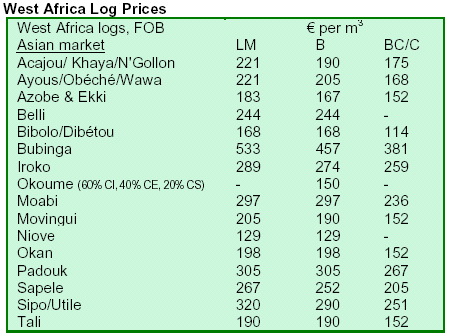
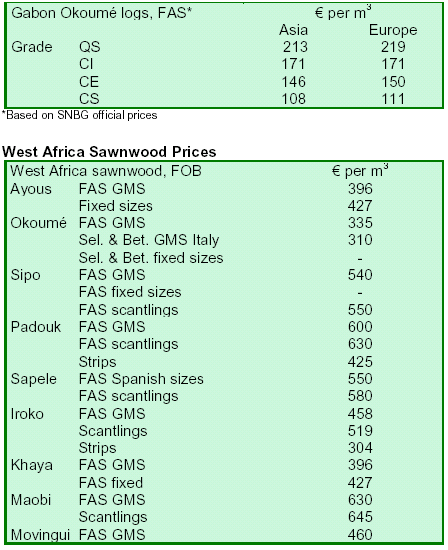
2. GHANA
Government announces initiative on mangrove replanting
The Minister of Local Government, Rural Development and Environment, Mr. Stephen
Asamoah-Boateng, announced that the government would embark on a vigorous programme to
replant mangrove plants along all lagoons in the country. He made the announcement during
a courtesy call by Regional Environment Officer of the U.S. Embassy in Accra, Mr. Geoffrey Hunt.
The Minister noted the recent change in the rainfall patterns had resulted in droughts within parts of the
country. He said the mangrove initiative would ensure that all water bodies were protected for
the current and next generations. He also mentioned that the mangrove initiative was part of the
government¡¯s plan to replant trees in degraded forest areas to protect the environment, adding
that the initiative had been spearheaded by his Excellency, President J. A.
Kufuor.
Ghana records robust surge in wood product exports
As reported by EUWID, shipments of Ghanaian wood products increased 28% in volume and 17% in value
during the first quarter of 2007, up from previous year estimates. The Ghana Timber
Development Division published data that revealed exports from January ¡§C March
2007 increased to 136,898m3 from 106,892 m3 during January ¡§C March 2006. Ghanaian plywood shipments also
rose approximately 50% to 6,903m3, and overland exports had more than doubled. Exports to Europe
remained about the same, while shipments to Asia, other African countries and the US showed upward trends.
Ghana trims foreign debt to US2.7 billion
The Minister of Finance and Economic Planning, Mr Kwadwo Baah-Wiredu, told Parliament on
Tuesday that Ghana¡¯s total foreign debt stood at US$2.7 billion as of April 30, 2007. According to him, the debt stock consisted
of US$2.2 billion long-term and US$462.8 million short-term debts, which dropped sharply from US$6.6 billion in
debt the country owed in 2000. Mr Baah-Wiredu explained that the US$2.2 billion consisted of US$1.3
billion owed to multilateral agencies and US$931.24 million owed to bilateral development partners.
Meanwhile, the President of the Republic of Ghana expressed optimism that the Swiss
President¡¯s favorable
impressions of her visit to Ghana would affect her country¡¯s future budgetary support to Ghana.
Switzerland¡¯s annual budgetary support to Ghana stood at US$10 million.
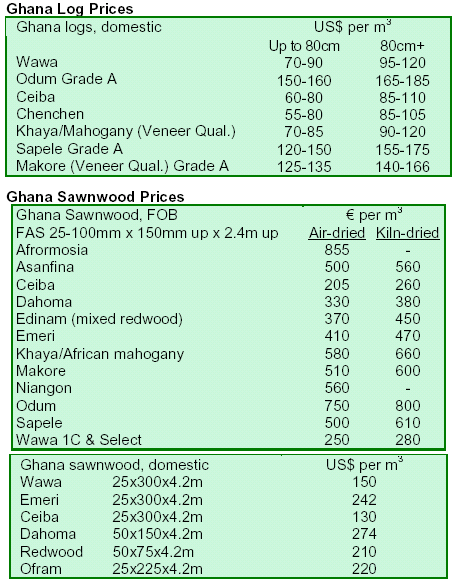
3.
MALAYSIA
Malaysia¡¯s trade surplus eases in May
Malaysia recorded a lower trade surplus of RM7.9 billion in May 2007, in comparison with RM8.0
billion in May 2006, according to the Malaysian Statistics Department. The Department attributed
the decline to an influx of RM1.4 billion (3.5%) worth of imports against an increase
in exports of RM1.3 billion (2.7%). Total exports were valued at RM49.6 billion compared with RM48.2 billion
in May of last year. Exports of timber and timber-based products grew by 9.3% to RM9.7 billion.
Talks on VPA will focus on technical issues
Malaysia and the European Union (EU) would continue negotiations on the Forest Law
Enforcement, Governance and Trade (FLEGT) voluntary partnership agreement (VPA) to resolve a
number of technical issues. Sarawak Timber Industry Development Corporation
(STIDC) general manager Datu Len Talif Salleh mentioned that both sides needed to define the parameters for the
VPA¡¯s operation. Presently, Malaysia has to negotiate with individual EU countries to export its
timber and wood products.
Soft loans awarded for forest plantation development
Forest Plantation Development Sdn. Bhd. (FPDSB) will disburse soft loans worth RM60.6 million to five
companies for forest plantation development. FPDSB would manage the Malaysian Timber
Industry Board¡¯s (MTIB) RM200 million fund allocated by the Finance Ministry for the planting of
75,000 ha of forest plantations from 2006 to 2008. The recipients ¡§C Ta Ann Holdings
Bhd, Modal Jati Bhd, SPPT Development Sdn Bhd, Hamid Sawmill Sdn Bhd and Amanah Saham Pahang
Bhd, would develop a total 12,235 ha in the states of Pahang, Johor, Terengganu and Sarawak.
New National Timber Industry Policy to be launched soon
The Plantation Industries and Commodities Ministry will soon release the National Timber Industry Policy, which is
currently in the final stage of development. The Ministry¡¯s Deputy Minister Datuk
Anifah Aman said the policy had developed various strategic plans to help the timberindustry move up the value chain. Once completed, the
policy would give a clear guide to the development of the Malaysian timber industry to maintain its competitiveness.
Malaysia steps up efforts to meet import standards
The Malaysian Timber Industry Board (MTIB), the Forest Research Institute of Malaysia (FRIM) and Sarawak
Timber Industry Development Council (STIDC) have been working together to establish a
compliance system in line with Japanese Agricultural Standards. Japan had initiated requirements
on formaldehyde emission, which the three organizations were working to address. The
organizations were also engaged in joint efforts to secure recognition as the testing and certification
bodies. The proposed system would allow the organizations to undertake the necessary tests and
evaluations for woodbased products exported to Japan.
Taiwan imposed a similar requirement on all plywood and laminated veneer lumber (LVL) products, which would be
tested and certified for acceptable formaldehyde emission levels beginning July
2007. In addition, timber exporters would also have to comply with the CE (Conformite
Europene) Mark for the European Union (EU) market. As of September 1, 2007, timber meant for structural
use in the construction industry, for example, will have to display the CE Mark.
Wood-based industries decry shortage of raw materials
The Malaysian timber industry is concerned that a shortage of raw materials will threaten the
furniture, MDF and particleboard industries, reported The Star Online. The Malaysian Wood
Resource Task Force (WRTF), an industry alliance of furniture and panel board companies
in Peninsular Malaysia, expressed concerns that industry players were not able to keep pace due to
the decline in raw material supply. According to the WRTF chairman, Peter Fitch, a few
public-listed companies in the wood panel business had to venture to Thailand and Indonesia
due to insufficient supply of local rubberwood. Malaysia was facing increasing competition from low-cost
countries with a good supply of raw materials.
A report by the Malaysian Institute of Economic Research (MIER) entitled ¡¡ãProspects, Challenges and Proposals for
the Wood Based Industry¡¡À noted that the supply shortage was predicted to become serious in 2012. Furthermore,
Malaysia's furniture export value could potentially rise to RM12bil in 2010 from RM7.7bil in 2005. Unless
manufacturers of rubberwood furniture would have access to adequate supply of raw materials, this huge business
opportunity would sadly pass by, it said.
Fitch suggested that furniture and panelboard players needed the backing of the federal and state governments to
establish sustainable forest plantations, as proposed in the MIER report. Despite
the growth, it said, the supply of raw materials had fallen due to the reduction in total area
replanted, as plantation owners had been shifting to oil palm. The growth of Malaysia's wood-based
exports might be short-lived if measures to turn around the supply of raw materials to the furniture and panel board (F&P) industries
were not implemented, said WRTF Chairman Fitch.
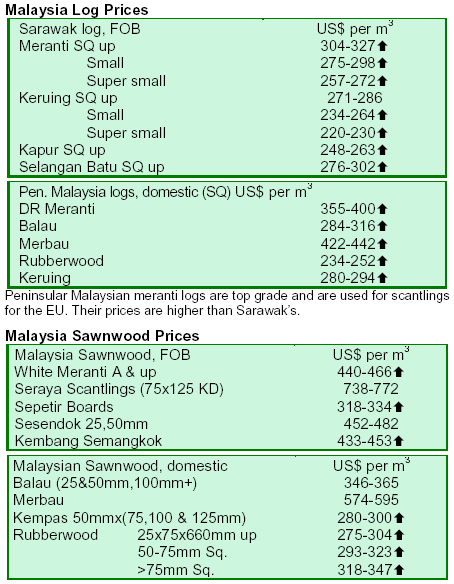
4.
INDONESIA
Reforestation to provide livelihood for 360,000 families
Villagers living in remote areas of Sumatra and Kalimantan would earn extra income by the end
2007 by participating in reforestation schemes funded by lowinterest loans from the Reforestation Finance Agency
(BPPH). The agency, which was established by the Forestry Ministry, would provide loans of up to Rp 6.34
million (around US$698) per hectare for those interested in planting trees on denuded or degraded land.
The agency had earmarked 5.4 million hectares for the project, which would cover eight provinces in Sumatra and
Kalimantan, most of which had been badly affected by illegal logging. Roni
Saefulloh, Head of the Directorate General of Cooperation at the Forestry Ministry, said the
reforestation programme should provide livelihoods for 360,000 families, each of which could plant up to 15 hectares.
Indonesia launches initiative on SME development
The Indonesian Central Bank launched a program recently to enable small and medium enterprises (SMEs) to
develop commodity-based clusters, one of which is to support and promote rattan
furniture making in Central Java. Other programs include an on-line business data and
information service, a task force to find solutions to the various problems faced by SMEs in provinces and a
visitor center at the central bank's headquarters. Each cluster will serve as supporting units,
providing information and technical advice on various aspects of business activities.
Russian tax pushes Indonesian plywood prices up
Prices of Indonesian plywood rose as news of a new Russian export tax on softwood logs hit
European and North American plywood manufacturers. Faced with the problem of raw material at home, importers from the EU
together with those from North America were reportedly combing Indonesia for plywood to address and mitigate the shortfall.
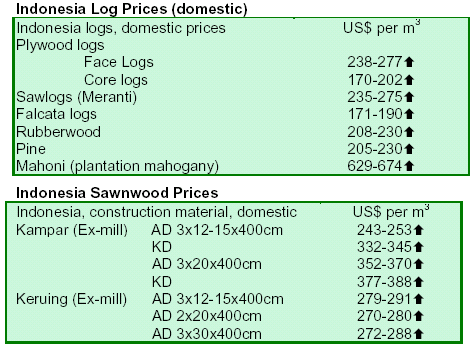
5.
MYANMAR
MTE uses PRATOS for teak log sales
It has been reported that the Myanmar Timber Enterprise (MTE) will be selling teak logs using a six
month¡¯s tender
average price ruling at the time of shipment (PRATOS). The six month¡¯s average
prices for July¡¯07 shipments would be as follows:
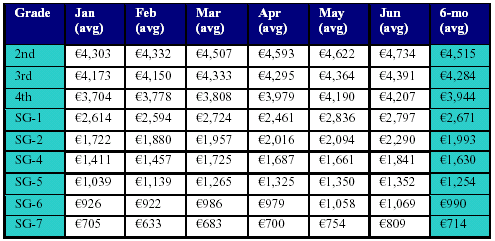
There was some unease reported among the timber traders
since higher prices were announced. Many said that using tender prices was not realistic as they represented the
highest spot prices and not actual market prices. Nevertheless, average prices were high because of the very
small quanity of teak sold each month. Tender prices could also rise in the heat of bidding or if there was
an urgent need for cargo. Many traders bid high in the tender sales and bring down the tender
average price by mixing teak species with other lower priced logs.
Sometimes, as was the case in June, the highest bid and the second highest bid for the same lot differed by about
EUR400. This happened quite frequently in the monthly tenders and gaps reflected the tender average prices
vis-avis the real market value. The high cost of raw materials could also make things harder for the local industry when
competing in the international markets. The local wood industry was said to be considering submitting an appeal
to MTE to reverse its decision to offer tender average prices.
Despite this trend, teak had in the past defied market expectations. Teak had not been squeezed from the market
because of frequent price escalations. Although MTE raised prices in the past,
business was sustained. It had been reported that some traders had already accepted the
new terms ¡®at prevailing prices¡¯ to enter into new contracts. As a result, the market could still prove to be
resilient, although some believe the temporary resilience is due to the short supply of teak in
Yangon.
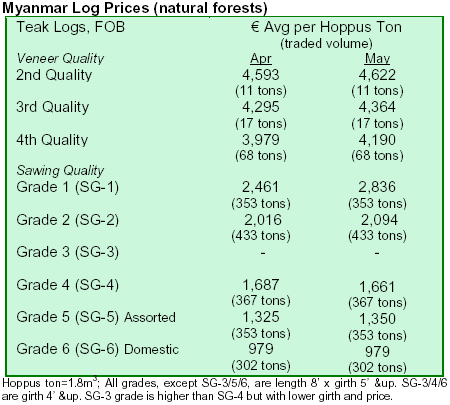
New, lower quality grades of ER-1, ER-2, and ER-3 (ER -
export reject) pyinkado and gurjan logs were now being sold in log yards country-wide.

6. BRAZIL
Para looks to forest plans to boost supplies
The wood industry in the state of Para has been facing one of the worst crises in recent years due
to lack of raw materials. Without enough raw materials, a number of companies have drastically
reduced production or stopped activities in an attempt to mitigate financial losses. Some
companies are being forced to fire employees as a result of the unstable environment.
Despite this development, the sector has reason to remain optimistic. The Executive Secretary of
Science, Technology and the Environment (SECTAM) announced that it would review 100 forest
management plans by mid- August. If such a goal is fulfilled, the government would
be able to minimize the crisis in the wood industry, which has already impacted the
year¡¯s production and
resulted in the lay off of over 20,000 employees. The government¡¯s objective is to accelerate the
analysis of the projects to make forest management a tool to promote sustainable
development and curb deforestation.
To reach such a goal, SECTAM intends to intensify the work of a taskforce it has established to address this
problem. Many believe that the government should impose such goals in order to
minimize the crisis of a sector that employs more than 180,000 people and makes important
socio-economic contributions to the state.
ATIBT to hold Tropical Wood International Forum in Belem
The interchange of information, technical contacts, evolution and perspective on the tropical wood market
(natural forest wood) in the world will be debated at the next Tropical Wood International
Forum, sponsored by the Association Technique Internationale des Bois Tropicaux
(ATIBT). The event is scheduled to be held in the cities of Santarem and Belem, in the Brazilian Amazonian state of
Para, from 11 to 16 November 2007.
ATIBT has chosen Brazil to host its event in 2007 because the country has been the top exporter of tropical wood
products in South America. In particular, the state of Para has been selected in
recognition of its large and modern industrial park that fulfils the requirements of the
international market for industrial and manufactured wood products. This is the second time that Brazil is hosting the
Forum, the first of which was held in the city of Manaus in 1984.
According to ATIBT, the event will discuss three main topics: (i) evolution of worldwide forest
management, focusing on forest certification, concessions and regulation; (ii) electric power
generation through biomass, focusing on offset for carbon emissions, climate change
and global warming; and (iii) value addition to forest products.
The event is expected to attract some 300 participants, representing Brazil, Europe and some
African countries, exchanging positive experiences involving the production and consumption of
tropical wood.
Civil construction fuels hefty growth in domestic market
Growth in the Brazilian civil construction segment has led to a 30% increase in domestic demand for wood products.
The rise in international prices and the growth of civil construction in the
Brazilian market have helped to partially alleviate the effects on the struggling solid wood
industry.
The solidwood industry has been facing a severe crisis over the past two years as a result of the weak US dollar
and the declining growth in housing starts in the United States. Higher prices for
solidwood products and the growth of the civil construction sector would alleviate the
difficulties faced over the past few years.
According to the Brazilian Association for Mechanically Processed Timber (ABIMCI), sectoral investments will
remain below the USD5 billion anticipated during 2005-2014. Many companies have postponed their expansion
projects due to unfavorable exchange rates, which would result in low margins and profits. Despite the fall of up to30% in exported volumes of wood products in 2007,
revenues from exports would likely remain close to those obtained in 2006 due to an increase in
international prices. The price hike reaches 30% in some segments, pulled mainly by the growing
demand for civil construction in Europe.
Europe has replaced the United States as the top importer of Brazilian wood products. Official
estimates of new housing starts in the US were projected to be 1.8 million in 2007 but
have been revised downward to 1.5 million units. In addition to the downturn in the US market, the US also
imposed import taxes on certain wood products after Brazil exceeded the allowed quota established
in the U.S. General System of Preferences (GSP). As result, the import tax for
plywood has risen from 0 to 8%. Many companies are redirecting their sales to European markets and the Brazilian
domestic market. ABIMCI foresees an increased between 25% to 30% in sales within the domestic
market due to growth in civil construction and the implementation of the Brazilian Growth
Acceleration Program (PAC).
French companies seek business partners in Brazil
Entrepreneurs from Bourgogne, France, and the state of Parana, Brazil, met in June at the
Business Round in Curitiba, Brazil to expand commercial relations, propose new business and
identify opportunities of strategic cooperation in the solidwood segment.
Promoted by the Federation of Industries of the State of Parana (FIEP), the Business Round
supported commercial contacts to generate future business. According to theFrench businessmen, the main objective was to discuss
opportunities for solid wood producers from the state of Parana, a major Brazilian producing state that offers large
potential and capacity for production and exports.
In addition to individual meetings to share experiences and technologies, the French entrepreneurs also had the
opportunity to visit Brazilian companies. The attitudes ofstate producers to these visits were favorable, as they wereconfident of being able to fulfil French
businesses¡¯ requests for volume and ]product quality.
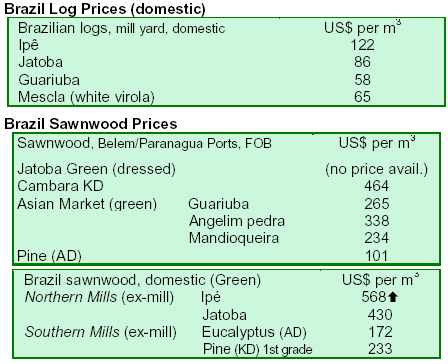
7. PERU
OSINFOR rescinds 40 forest concessions
According to Helmut Scheuch, Director of the Supervision, Evaluation, and Control Unit of the
Supervisory Body of Wood Forest Resources (OSINFOR), the body withdrew 40 forest concessions for lumber
generation due to problems with the management and extraction plans on the said areas. Mr. Scheuch said that
among the reasons for the number of rescinded offers of concessions were the failure of the management staff to
implement forest management plans, prevent logging occurring outside the concession areas, and submit a
sustainable development management plans. He predicted that a number of stakeholders in some regions like Loreto,
one of the richest forest resource zones, would disagree with ONSINFOR¡¯s decision.
Coca adds to deforestation in Amazon
Lucio Batallanos, Manager of Environmental Conservation for the Comision Nacional para el
Desarrollo y Vida sin Drogas (DEVIDA), indicated that 2.5 of the 7 million ha of deforested
Amazonian forests were due to cutting for lumber, charcoal, and bushmeat trade.
Batallanos indicated that 3.9 billion Peruvian soles was also lost from the clearing of forests for coca
cultivation, as discussed in a new study by the World Bank. The Bank noted that coca cultivation was stripping valuable nutrients
from the soil and that the situation would worsen due to the techniques used to produce large scale and high yield
coca areas.
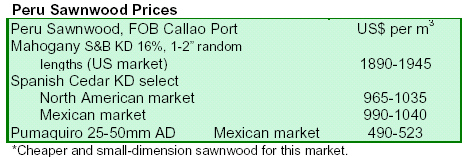
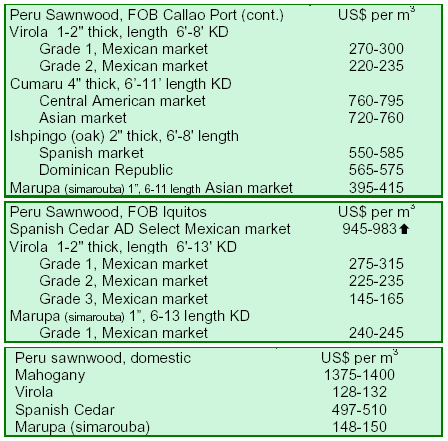
8. MEXICO
World Bank grants US$7.35 million to Mexico for
SINAP II
The World Bank announced it had granted Mexico US$7.35 million as part of the third tranche of
funding for the ¡¡ãConsolidation of the Protected Areas System (SINAP II) Project¡¡À. The grant would
be used to conserve the National System of Protected Areas, which would help
promote the conservation and sustainable use of biodiversity. Yoko Wantanabe, Program Manager in
Biodiversity for the Global Environment Facility (GEF) Secretariat, noted that the project supported such
initiatives including: conserving globally important biodiversity in the National Protected Areas
System; promoting economic, social and environmental sustainability of productive activities;
promoting social coresponsibility for conservation; and supporting the inclusion of biodiversity,
conservation, and sustainable criteria in development projects. This project would cost a
total of US$60.12 million and was scheduled to be complete by 2010.
CONAFOR announces National Award of Forest Merit 2007
The National Forest Agency (CONAFOR) recently announced the winners of its National Award of
Forest Merit 2007. In the category of commercial forest plantations, the award was given to Agros
Navidad, S.A. Two awards were given to entities in the state of Veracruz: one for sustainable forest
management was given to La Flor de Catemaco, S. de P.R. de RL de C.V. and another
for protection and forest restoration was given to Agroproductores Forestales de Zacualpan, S.P.R. de R.L.
9.
BOLIVIA
Bolivia sustains robust export trends
During the two-month period of May to June 2007, companies from Santa Cruz and La Paz, the two main
wood exporting regions in Bolivia, exported US$40.2 million worth of wood products, a 42%
increase compared to the same period in 2006. More than two-thirds of the exported value was
generated by high value-added products such as furniture, doors, flooring, particleboard
and veneer. In Santa Cruz, growth of high value-added products in terms of volume exceeded 40%. In La Paz,
growth reached 34%. For sawn wood products, the overall growth in terms of volume was 24%.
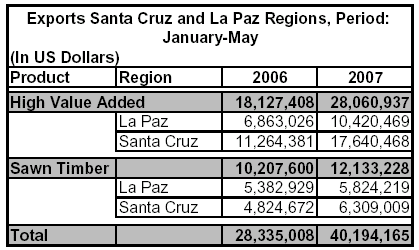

10.
GUYANA
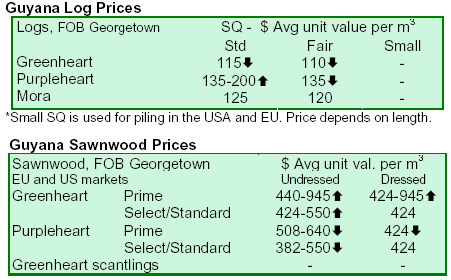
|